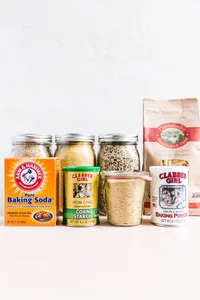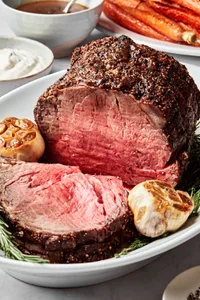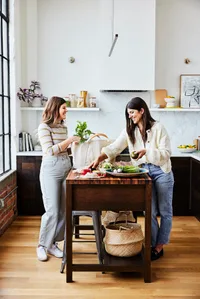Pantry Essentials: The Dry Goods Every Pantry Needs
Pantry shelves stacked neatly with a bounty of grains make us really, really happy. Gleaming glass jars full of whole grains like oats, cornmeal and brown rice, waiting to jump into a pot of boiling water and help us get dinner (or breakfast, or lunch) on the table quick. Just the sight of it is enough to soothe the soul of even the busiest home cook.
You may wonder just exactly what is this magical, soothing assortment of dry goods that qualifies a pantry as well-stocked? We’re so glad you asked! Whether we’re scrounging for breakfast in a hurry or hosting a last-minute dinner party, these are the nine dry goods that save us every time.
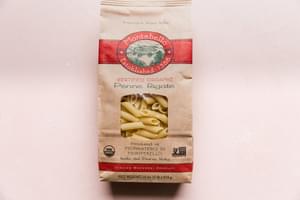
Dried Pasta
Pasta is life. There’s no denying it. Especially if you have kids, pasta is a sanity-saving life raft in a sea of play date-shuttling, homework-helping, and general chaos-managing. From penne to angel hair, pasta is a crowd-pleaser. Ready in minutes, and it can be topped with just about anything you’ve got lurking around in your fridge or pantry.
Our Best Quick & Easy Pasta Recipes:
It’s true that nothing is easier than opening a jar of pasta sauce and dumping it onto the noodle of your choice—and there’s nothing wrong with calling that dinner! We’ve been there. But, if you’ve got a few more minutes, these pasta recipes are immensely more satisfying:

Quinoa:
Loaded with protein and fiber, and ready in about 20 minutes, quinoa is an ancient grain that we can’t get enough of. We love to cook a big batch on the weekends and keep it in the fridge, ready to serve as the base for our favorite quick, super-healthy dinner—a vegan quinoa bowl. Just top a big pile of cooked quinoa with some roasted veggies and maybe a leftover protein (roasted chicken, or simply some cubed tofu), pour a little dressing on top, and gobble it up!
How to Cook Quinoa:
- Rinse. Place your quinoa in a fine mesh sieve and rinse it under cold water.
- Measure. You’ll want a ratio of about two cups water to every one cup of quinoa.
- Boil. Bring two cups of water to a boil, and add the uncooked, rinsed quinoa. Cover and simmer until all of the water has been absorbed and the quinoa is tender, about 20 minutes.
- Enjoy!
Our Best Quinoa Recipes:
Quinoa is super versatile! Once you’re in the habit of cooking it, you’ll find yourself using it all the time. Here are three of our quinoa recipe faves:
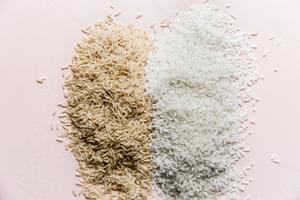
Rice
We always, always have rice on-hand—often both brown and white, but at least one of the two. For some reason, rice scares people. It’s a grain that a lot of home cooks—at least the ones without a rice cooker—think that they can’t cook, or at least can’t cook properly. But it’s not that hard, we promise! And once you’ve got the hang of it, you’ll be making it all the time.
How to Cook Rice:
Yes, cooking rice is a lot easier if you have a rice cooker. And if you love Asian food, and think you might be making it often, a Rice Cooker is definitely a worthwhile investment. If you’re not ready to invest, though, it’s easy to make rice in a pot on top of the stove. Here’s how:
- The ratio of water to rice varies a bit from white to brown, basmati to jasmine. As a general rule, the ratio for white rice is 1 cup of water to 1 cup of rice. For brown rice, that ratio is 1 3/4 cups water to every 1 cup of rice. You should be able to find the suggested water to rice ratio on the packaging (or if you’re buying in bulk, the ratio should be listed on the bulk bin.)
- Bring a pot of water to a rolling boil before you add the rice. Some people lightly salt the water, and you can do that now if you’d like to.
- Once the water has come to a boil, add the rice and stir it gently once. Turn the heat down as low as possible.
- Cover your pot and let the water and heat work their magic. A nice gentle steam will yield fluffy, perfect rice.
- Let the rice cook for about 18-20 minutes.
- Remove the pot from the heat and let it sit—still covered!—for another ten minutes.
- Take the lid off and fluff your rice with a fork. And you’re done!
Our Best Rice Recipes:
Or, should we say recipes?! Oh boy. Sorry about that. Anyway, here are three of our favorite recipes with rice:
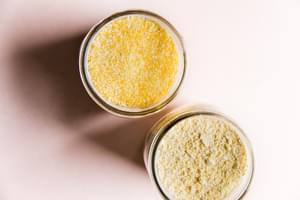
Cornmeal / Polenta.
From cornbread to grits to creamy Italian polenta, no kitchen pantry is complete without cornmeal. It can go sweet—is there anything better than hot-out-of-the-oven cornbread, slathered in butter and sticky with honey? Or, it can go savory—polenta whisked with cream and lots of cheese makes one heck of side dish for just about any meaty main. We love it, and it’s definitely earned its keep as a pantry essential.
Our Favorite Cornmeal Recipes:
Cornmeal so often feels like the forgotten grain. No more! These three recipes are sure to bring you over into the “I love cornmeal” camp:
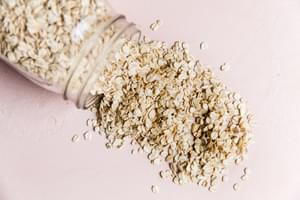
Oats
Nutty, hearty and nostalgic oats are a true blue, healthy, whole grain classic. They’re a great source of protein, too. They are also naturally gluten free, although people with dangerous gluten allergies should be sure that the brand of rolled oats that you select has a guarantee of no cross-contamination with other grains that may contain gluten. We always have Gluten-Free Oats on hand!
Our Best Oat Recipes:
Whether we’re filling our kids’ bellies with a warming, rib-sticking breakfast in the winter, or whipping up a batch of oatmeal-raisin cookies when that late-night craving hits, oats are one of our family’s favorites. Rolled oats, to steel cut, to instant oatmeal—you can’t go wrong. Here are three of our favorite recipes featuring oats:
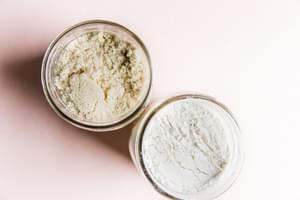
All-Purpose Flour
What is a home without all-purpose flour? Without the ability to mix up a batch of cookies, or pancakes or pizza dough at a moments notice? Not a home we’d like to live in, that’s for sure. We never, ever run out of flour, and we wish you all flour-filled days, too!
What is Flour Made From?
High quality, unbleached, all-purpose flour is made simply from wheat that has been milled down into a fine powder. King Arthur All-Purpose Unbleached Flour is the gold standard for home bakers and cooks, and it is what we keep in our pantry for everyday use. Other flours—like bread flour, super fine cake flour or self-rising flour—have their moments, too. But as far as pantry staples go, it always comes back to classic all-purpose flour.
Baking Up A Storm!
In case you need another reason to get in the kitchen and bake, here are three of our flour recipe faves:
Almond Flour
As much as we love all-purpose flour, there’s a new flour on the block that has stolen our heart—almond flour! Made from almonds that have been blanched and then ground into a super-fine meal, almond flour is a must-have for grain-free baking. Because almonds—like all nuts—are high in fat, almond flour has a relatively high oil content. This makes goodies baked with almond flour extra moist and tender—yum— and also means that it’s a good idea to store your almond flour in the fridge so that it stays fresh.
Can You Substitute Almond Flour for All-Purpose Flour in Baking?
Subbing some almond flour for the all-purpose flour is an easy way to lower the carbs—and up the protein—in just about any baked good. As a general rule, you can safely substitute almond flour for 1/4 (25%) of the flour when making non-yeasted baked goods like cookies or muffins. Check out this Baking With Almond Flour Post for more info on swapping almond flour for all-purpose flour.
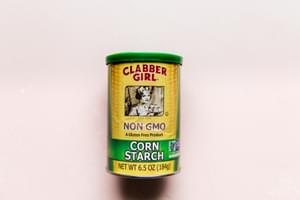
Cornstarch
While we do sometimes reach for it when we’re baking, we primarily love cornstarch because we love to make stir-fried everything! A light coating of cornstarch all but guarantees that your stir-fried chicken (or fish or beef) will be gorgeously golden-crisp on the outside, and juicy-tender on the inside. We also love it for its unique thickening capabilities. A little cornstarch whisked into water is a classic way to thicken soups and stews, like our Classic Beef Stew.
Is Cornstarch Gluten-Free?
Made from the dried, powdered endosperm of a corn kernel, cornstarch is indeed gluten-free!
Our Favorite Stir-Fries:
Cornstarch is the secret to every great stir-fry, and these three recipes prove it!
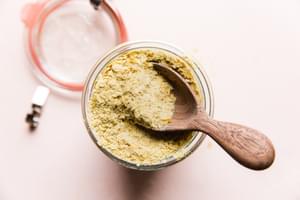
Nutritional Yeast
High in B vitamins and packing a powerfully flavorful punch, nutritional yeast has got to be one of our favorite healthy-but-delicious (and vegan!) ingredients. We sprinkle it on popcorn, and on top of salads, and we really love to use it in vegan sauces and dressings.
What is Nutritional Yeast?
Good question! Nutritional yeast is made from Saccharomyces Cerevisiae (a species of yeast), that is cultivated on top of molasses. It’s then harvested and “deactivated” via a heat treatment. This may sound less than appetizing, but trust us, it’s a keeper! Nutritional yeast is chock-full of amino acids and B vitamins, it's vegan, sugar-free, gluten-free and it basically tastes like parmesan cheese. We are loyal fans of Bragg’s Nutritional Yeast, but you can often find it in the bulk bins of your local grocery store, too.
A Few of Our Favorite Recipes with Nutritional Yeast:

Baking Powder & Baking Soda
We all know that no pantry is complete without baking soda and baking powder, right? But what are baking soda and baking powder made of, exactly? And do you really need both, or can you substitute baking powder for baking soda? Well, of course, the answers to these very good questions aren’t all that simple. But we’ll do our best!
What’s the Difference Between Baking Soda and Baking Powder?
Baking soda is pure, 100% sodium bicarbonate, where as baking powder is sodium bicarbonate that has been cut with other ingredients. Baking soda must be mixed with an acidic ingredient to be activated—in other words, to produce the gasses that will make your cookies, cakes and quick breads rise. Baking powder, on the other hand, already has the acid that it needs to be activated mixed in.
Can I Use Baking Soda Instead of Baking Powder?
In short, yes you can! But you’ll need to be sure that you’ve got enough acid—a bit of lemon juice or vinegar, for example—in whatever you’re baking to activate the baking soda. It’s not rocket science, but it is baking science, and the mathematics of substitutions can get complicated quick! We prefer to stock both baking soda and baking powder, to be safe.
And When In Doubt, Use Both Baking Powder AND Baking Soda!
These three sugar-y goodies get a boost—literally—from both baking soda and baking powder. They are also absolutely, 100% certified deliciously addictive. Get baking!

So, what dry goods do you consider to be pantry essentials? Did we miss one of your faves? Share your thoughts with us in the comments or tag us on Instagram @themodernproper and #themodernproper.
